- Products and Solutions
- Industry Solutions
- Services
- Support
- Training & Certification
- Partners
- About Us
- Contact Sales
- Become a Partner
-
 Login
Login
Country / Region
 Products and Solutions
Products and Solutions Cloud & AI
Cloud & AI Computing Virtualization
Computing Virtualization Flagship Products
Flagship Products H3C CAS Virtualization Platform
H3C CAS Virtualization PlatformH3C CAS Virtualization Platform
H3C Cloud Automation System (CAS) is a virtualization and cloud computing management software independently developed by H3C for data centers. It uses a virtualization kernel that meets telecom-grade performance and availability requirements and supports integrated delivery of computing, storage, network, and security virtualization resources. CAS can minimize the number of data center servers, consolidate IT infrastructure resources within the data center, streamline IT operations, and enhance management efficiency, which ultimately increases physical resource usage and decreases total ownership costs considerably. Using this state-of-the-art virtualization and cloud operations management system, the IT department can build a secure, reliable data center environment that quickly responds to the demands of business departments and offers better services at lower costs.
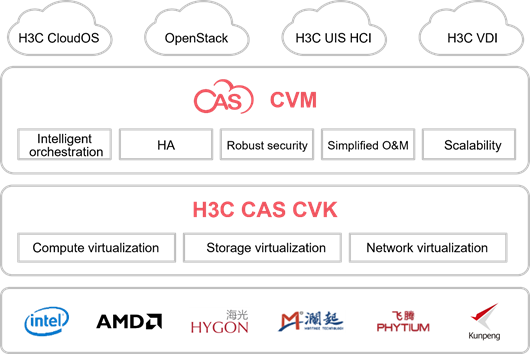
H3C CAS architecture
H3C CAS consists of the Cloud Virtualization Kernel (CVK) and Cloud Virtualization Manager (CVM) components, providing powerful data center virtualization and management capabilities.
CVK runs between the underlying infrastructure and the upper-layer guest operating systems (OSs). It isolates the guest OSs from the underlying hardware. The guest OSs accesses the infrastructure through CVK without having to concern about the varieties and complexities in hardware. CVK is essential to the performance of CAS in hardware compatibility, high reliability, scalability, and performance optimization in a virtual environment.
CVM manages virtualization of computing, network, and storage resources within the data center and provides automated services for upper layer applications. It provides services including virtual computing, virtual networking, virtual storage, high availability (HA), dynamic resource scheduling (DRS), dynamic resource expansion (DRX), GPU resource pool, virtual machine backup and recovery, KVM virtualization management, vSwitch management, high reliability management, virtualization security management, and log audit interfaces. In addition, it offers open northbound REST interfaces and plugins compatible with OpenStack to integrate with third-party cloud management platforms and standard OpenStack cloud platforms (including versions such as Liberty, Mikata, Pike), respectively, shielding the complex and heterogeneous virtualization infrastructure beneath.
Wide-ranging compatibility
Compatible with multiple CPU architectures and prevalent operating systems, databases, and middleware in the industry, CAS supports unified management of X86/ARM clusters, enables collaborative creation of a hardware and software ecosystem, and drives business innovations.
VMware-compatible
Supports unified management, one-click migration, and seamless disaster recovery for VMware virtualization.
All-round security protection
Provides security protection mechanisms at the kernel, data, service, and management layers, ensuring compliance with security requirements and comprehensive protection for the service system.
The kernel is embedded with a security protection engine that offers agentless antivirus and deep packet inspection, ensuring security for both virtual kernels and virtual machines.
One-click highly efficient O&M
Intuitive display of the virtualization topology, comprehensive and detailed performance monitoring, and customizable statistical charts and reports simplify management and facilitate O&M.
The innovative one-click virtualization O&M features including one-click health inspections, one-click resource analysis, one-click storage cleanup, make complex operations in daily operation and maintenance easy to accomplish.
Scenario-specific solutions
The DRX solution enables dynamic scaling up or down of resources according to the workload of the service system, and can address performance deficit issues during unexpected traffic spikes and guarantee optimal operation of the service system.
The cloud rainbow technology enables online migration of virtual machines across data centers, breaking the limitations of local deployment of service systems and enabling flexible deployment of service systems.
Open ecosystem
Open and customizable standard interfaces enable smooth integration with the OpenStack cloud platform architecture and broad compatibility with third-party software and hardware platforms.
Collaborate closely with vendors such as AsiaInfo Security, DataSure, AISHU, RunStor, MacroSAN, and China Standard Software to offer integrated virtualization solutions.
Cluster-based centralized management
H3C CAS organizes servers and virtual machines into clusters and provides a clear hierarchical structure view that intuitively presents the relationship between data centers, host pools, clusters, hosts, and virtual machines, greatly reducing the resource management workload.
The benefits of cluster-based centralized management are:
Through centralized management, administrators can organize, monitor, and configure the entire IT environment from a unified interface, which reduces management cost.
In the cluster, multiple independent servers form a shared resource pool, which not only reduces management complexity but also offers inherent high availability. H3C CAS monitors all servers in the cluster. Once a server fails, H3C CAS will respond immediately and migrate and restart affected virtual machines on another server within the cluster. H3C CAS also supports online migration of virtual machines and storage, allowing virtual machines to migrate across different storage types and storage products to migrate across different vendors without any interruption or downtime, thus providing users a cost-effective high availability (HA) solution.
H3C CAS supports dynamic resource allocation, allowing dynamic adjustment of virtual machine resources (including CPU, memory, disk, and network cards) online and offline.
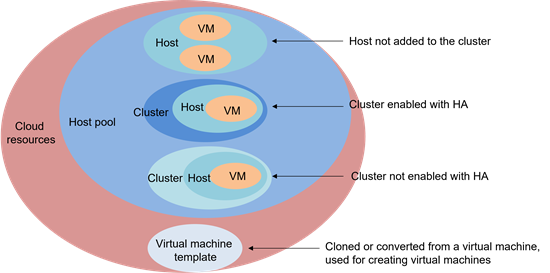
Cluster-based layered management
Full lifecycle management of VMs
CAS provides visualized full lifecycle management of VMs from their creation to deletion. System administrators can create, edit, start, suspend, resume, hibernate, restart, shut down, power off, clone, or migrate a virtual machine. They can also take snapshots of a virtual machine and restore the virtual machine based on a snapshot.
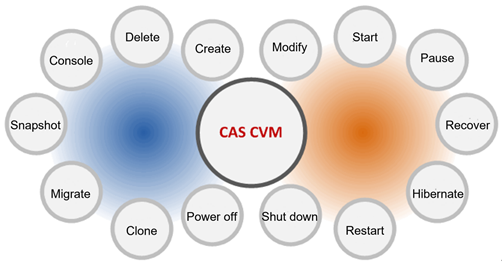
Full lifecycle management of VMs
High availability
H3C CAS provides cluster-based centralized management for the IT infrastructure in the data center. By virtualizing multiple independent servers into a cluster, CAS not only reduces management complexity, but also offers inherent high availability, providing users an economically efficient HA solution.
H3C CAS HA monitors virtual machines in the resource pool continuously and provides a heartbeat mechanism for servers and shared storage pools. When a virtual machine loses heartbeat, the system will attempt to restart the virtual machine locally or migrate it to another server and then restart it. Whenever a physical server shuts down, the system will immediately migrate virtual machines on the failed server to another available server in the cluster. H3C CAS uses an optimized high-performance cluster file system and allows different servers to visit the same storage file via different storage protocols, like SAN/iSCSI/NFS, making HA easy and convenient to implement.
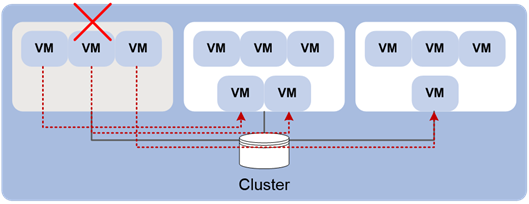
Using HA for server failover
Dynamic Resource Scheduler (DRS)
In a virtualization environment, a host would become a performance bottleneck as the number of virtual machines consolidated to it outgrew the resources available on the host. CAS DRS introduces an automated mechanism that continuously migrates virtual machines to servers with more available resources to ensure that every virtual machine can promptly access the resources on the node. With dynamic load balancing, the administrators do not need to monitor hosts for CPU and memory usage, even if they are running resource intensive VMs such as SQL server VMs. Fully automated resource allocation and load balancing helps drive down the costs and expenses to build and run a data center.
CAS DRS uses a heartbeat mechanism to periodically monitor the usage of computing resources, such as CPU usage and memory usage on servers in the cluster, and determine based on user-defined rules whether to migrate the virtual machine on a server to another server with more available resources or migrate other virtual machines out of the server, thus provisioning sufficient resources for critical virtual machines.
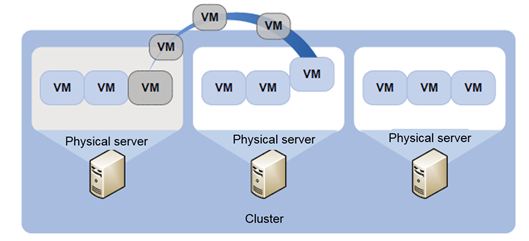
Dynamic resource scheduler
Dynamic power management (DPM)
H3C CAS supports monitoring resource usage such as CPU usage, memory usage, connection count on physical servers in the cluster. It reduces the energy consumption of data centers by dynamically migrating virtual machines and shutting down idle servers. When the workload in the cluster increases, the platform can automatically wake up previously shut down idle servers. With this, H3C CAS enables load balancing in the cluster.
Flexible resource allocation mechanism
H3C CAS supports allocation of compute, network, and storage resources on an as-needed basis. Allocation of computing resources is achieved through resource quotas and reservations for virtual CPUs and virtual memory. Allocation of network resources is achieved through the QoS feature of virtual switches. Allocation of storage resources is achieved through limiting the virtual machine disk IOPS (Input and Output Per Seconds) and throughput. These technologies are used to meet Service-Level Agreement (SLA) requirements, ensuring that high-priority virtual machines have better computing, networking, and storage performance while avoiding interference between services of virtual machines.
Unified management of GPU resources
H3C CAS provides a GPU resource pool, which enables unified management and scheduling of physical GPUs and vGPUs. Through GPU passthrough and GPU virtualization, GPU resources can be allocated and released graphically based on virtual machine requirements. This provides fast and efficient GPU resource provisioning capabilities for high-performance computing services in industries such as broadcasting, earthquake, meteorology, and design, reducing the O&M complexity.
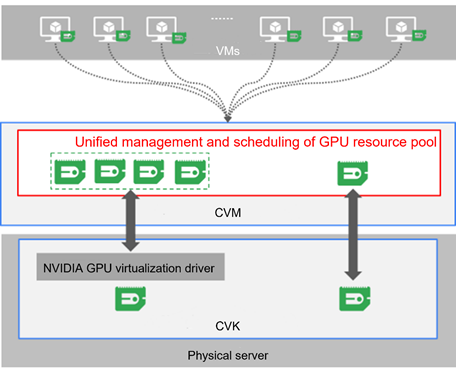
Unified management of GPU resources
Raw Device Mapping (RDM)
H3C CAS supports direct mapping of LUNs from SAN storage (FC or iSCSI) to virtual machines, allowing virtual machines to access raw devices and store virtual machine data directly on LUNs.
Distributed dual-stack vFirewall
H3C CAS supports both IPv4 and IPv6 addresses, and allows for selecting address types based on virtual machine requirements. Customized virtual firewall rules can also be issued. You can deploy distributed virtual firewalls on vNICs to protect VMs with different security policies. The security policy for a virtual machine moves along with the virtual machine as it moves between hosts to ensure uniform security enforcement across the network.
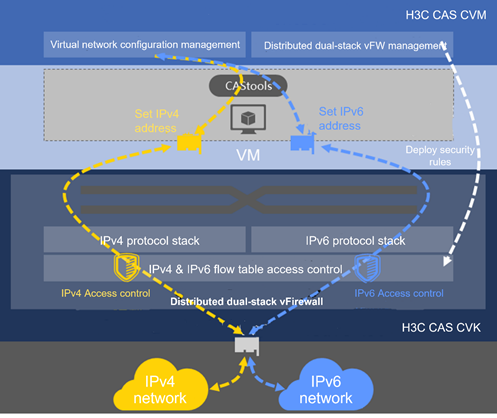
Distributed dual-stack vFirewall
Security protection of virtual machines
H3C CAS supports integration with third-party antivirus software or security software such as AsiaInfo Security, providing comprehensive security protection solutions in virtualized environments without the need to install agents inside virtual machines and guaranteeing security in virtualization environments.
Cost-effective, highly efficient backup and restore solution
H3C CAS implements transparent scheduled backup and instant backup, providing fast and simple data protection for virtual machines.
The backup feature of H3C CAS is an efficient and low-cost disaster recovery feature, which will bring the following benefits to users:
![]() Snapshot-based backup does not affect services.
Snapshot-based backup does not affect services.
![]() Backup without a need for additional proxies simplifies deployment complexity.
Backup without a need for additional proxies simplifies deployment complexity.
![]() Fully-automated scheduled backup and manual backup meet different application requirements.
Fully-automated scheduled backup and manual backup meet different application requirements.
![]() Support multiple flexible virtual machine backup methods, including full backup, differential backup, and incremental backup.
Support multiple flexible virtual machine backup methods, including full backup, differential backup, and incremental backup.
![]() Backup interfaces allow seamless integration with third-party backup software, enabling centralized backup of virtual machines.
Backup interfaces allow seamless integration with third-party backup software, enabling centralized backup of virtual machines.
Performance monitoring
Physical server performance monitoring
H3C CAS provides usage of computing resources such as CPU and memory and top 5 virtual machines with highest usage on physical servers in graphical charts. This provides administrators with detailed data for implementing reasonable resource planning.
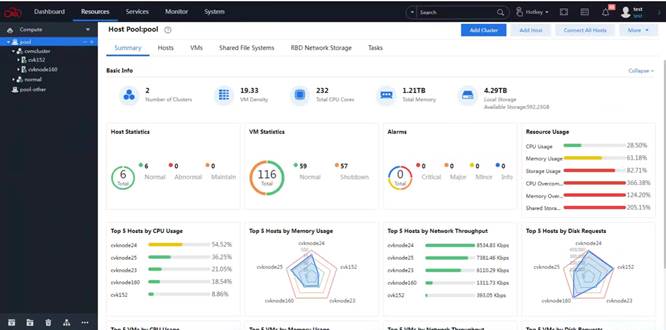
Physical server performance monitoring
Virtual machine performance monitoring
H3C CAS provides comprehensive monitoring for key resources such as CPU, memory, disk I/O, and network I/O on virtual machines.
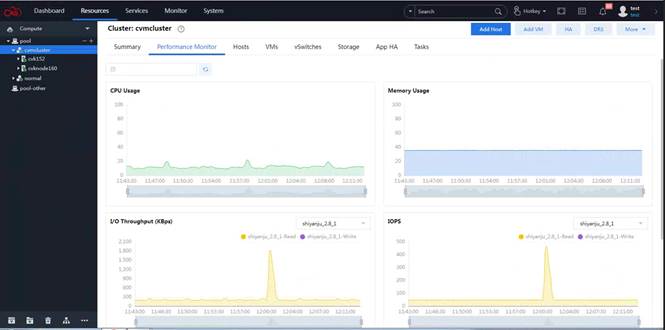
Virtual machine performance monitoring
Virtual switch status monitoring
H3C CAS can provide traffic statistics for each virtual port on the virtual switch and displays them graphically on the simulation panel.
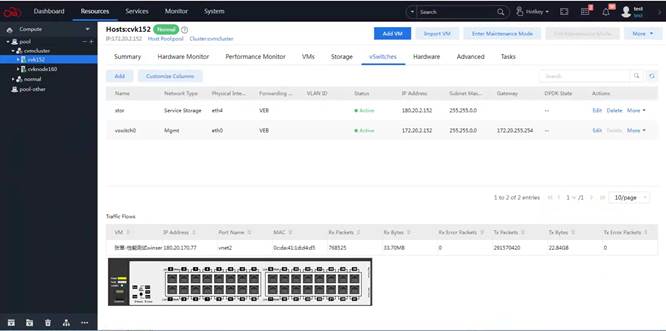
Virtual switch status monitoring
Virtual network adapter performance monitoring
H3C CAS can display incoming and outgoing traffic on virtual network adapters graphically in real time.
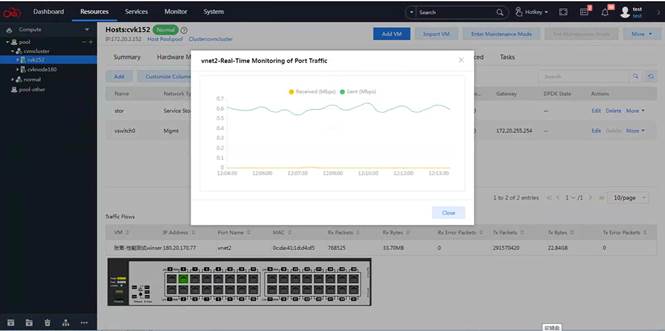
Virtual network adapter performance monitoring
Cool dashboard
H3C CAS can visually display the main performance metrics and resource status in the virtualized environment in real time on the dashboard. In the enterprise edition, users can customize the performance indicators and resource status displayed on the dashboard according to their needs. The customizable metrics include but are not limited to host performance, virtual machine performance, shared storage performance, overall system health, host health, CPU allocation ratio, memory allocation ratio, storage allocation ratio, system alarms, Top 5 hosts with highest CPU and memory usage, Top 5 virtual machines with highest CPU and memory usage, and host and virtual machine status statistics.
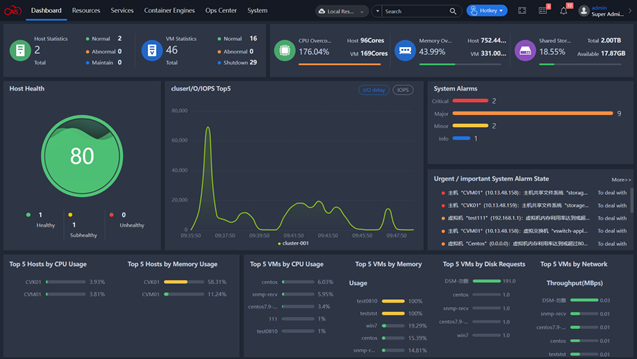
Dashboard
Convenient resource statistics collection and management
H3C CAS provides rich statistics for virtual machines in graphical charts, including virtual machine network traffic Top N, virtual machine network traffic statistics, virtual machine I/O throughput Top N, virtual machine I/O throughput statistics, virtual machine performance Top N, and virtual machine performance statistics, and supports statistics search by cluster, host, virtual machine, and time, which enables users to view virtual machine performance data easily. In addition, CAS supports output of host and virtual machine information in a report from clouds, host pools, and clusters in a standard CSV format, which enables system administrators to view, audit, and store host and virtual machine information easily.
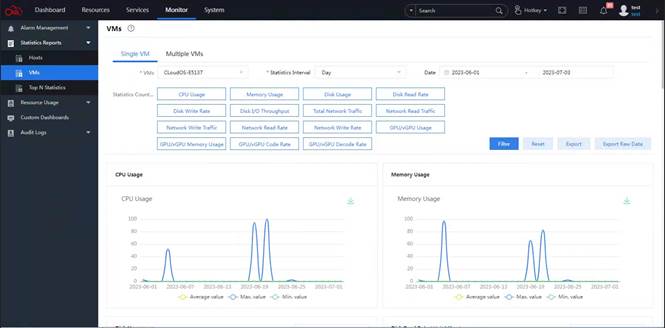
Rich virtual machine statistics
Intuitive virtualization topology
H3C CAS supports visually displaying the relationships between clusters, hosts, virtual machines, networks, and storage in a graphical manner, including virtual computing topology centered on computing resources, virtual network topology centered on virtual switches, and virtual storage topology centered on storage LUNs.
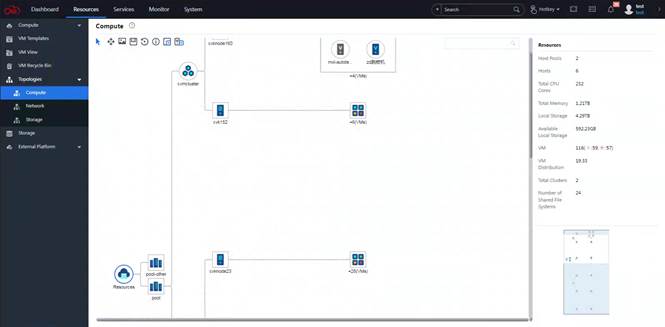
Intuitive virtualization topology
Highly efficient one-click operations
H3C CAS innovatively provides one-click O&M functionalities, including one-click health inspection, one-click resource analysis, one-click storage cleanup, one-click virtual machine restoration, making complex operations in daily management easy to complete. For example, it supports one-click inspection of the operating status of the cloud computing management platform and automatic generations of inspection reports and optimization recommendations. It also supports one-click removal of invalid storage volumes in shared storage, to free up storage space and improve storage use efficiency.
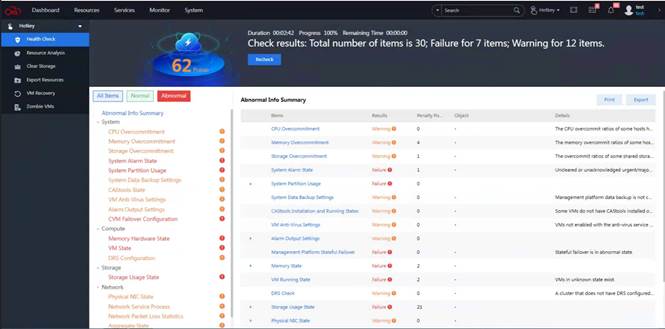
One-click O&M operations
Network-based USB redirection
H3C CAS supports network-based USB redirection. Virtual machines can use USB devices continuously without being affected by server migration, and service systems can operate physical USB devices without a need for a third-party software and hardware.
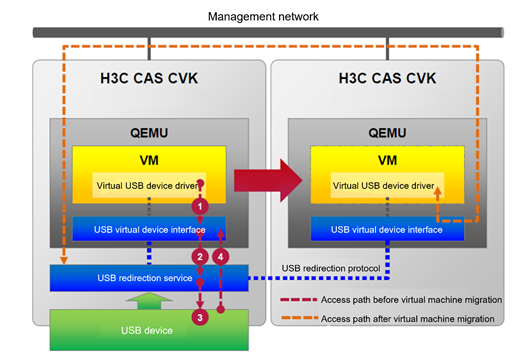
USB redirection
Dynamic Resource eXtension (DRX)
H3C CAS can implement dynamic resource extension based on workloads. It can dynamically clone or delete virtual machines based on parameters such as CPU usage, memory usage, and connection count. More virtual machines are engaged concurrently when there is a greater need for service, while a lesser number of virtual machines are used when the demand is smaller. When a normally running service encounters a sudden surge in traffic, H3C CAS can detect the insufficient performance of the virtual machine hosting the service, quickly replicate the virtual machine, and work in conjunction with load balancing devices to provide external services. After the peak traffic hour has passed, H3C CAS can dynamically shrink and delete excess virtual machines, thereby achieving on-demand computing resource allocation.
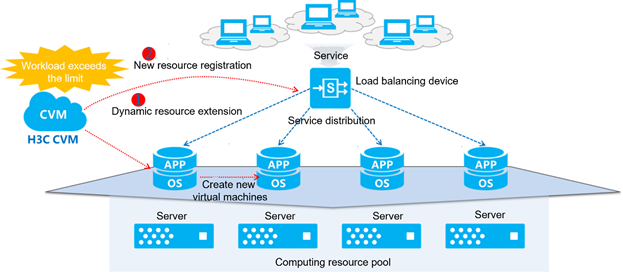
Dynamic resource extension
Virtual machine online migration across data centers
H3C CAS allows independent resource pools to interconnect across data centers. Online migration of virtual machines across data centers enhances service continuity and breaks the limitations of local deployment of IT resources and businesses. This provides enterprises with a global perspective on IT resource management.
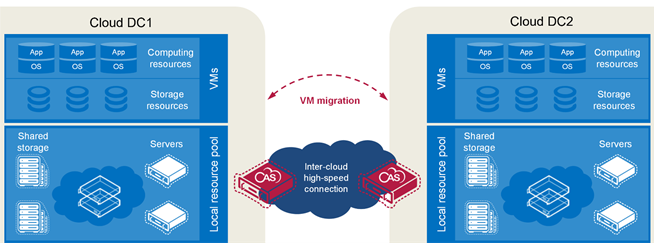
Virtual machine online migration across data centers
Unified management of multiple virtualization platforms
In scenarios where users have already deployed VMware vCenter Server, H3C CAS can be compatible with and manage some functions of the VMware vCenter virtualization platform through VMware APIs, achieving unified management of multiple virtualization platforms.
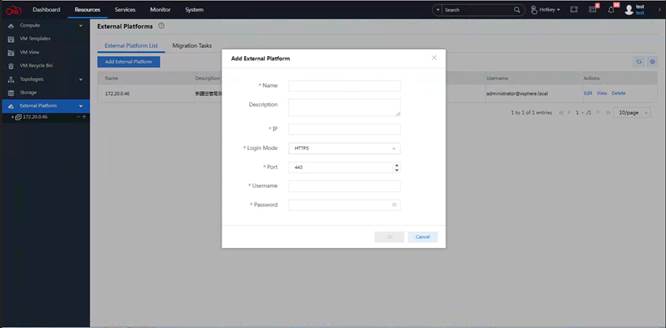
Adding VMware vCenter as an external cloud resource to H3C CAS
Centralized protection and auditing
H3C CAS provides flexible control on configuration and remote access permissions for virtual machines. Operation logs provide detailed records of significant operation actions, facilitating post-event auditing and tracking.
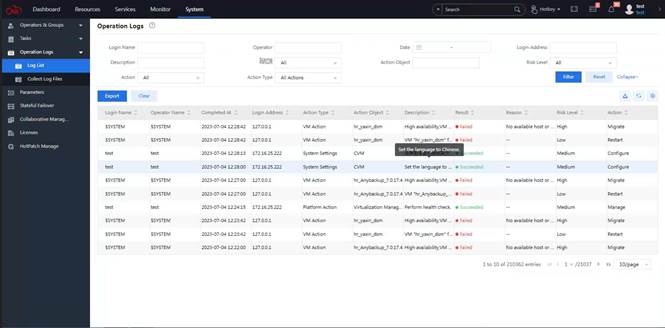
Detailed operation logs
Free trial plan
H3C CAS offers a 180-day all-functionality free trial plan. You can navigate to the CAS section at the H3C official website to download the latest CAS software use guide and experience the stable and easy-to-use virtualization software.
Ordering information
Item | Description | License Type |
H3C CAS, Cloud Virtualization Manager Standard Edition License, 2 Physical CPUs | Optional for the standard edition. | Perpetual |
H3C CAS, Cloud Virtualization Manager Enterprise Edition License, 2 Physical CPUs | Optional for the enterprise edition. | Perpetual |
In collaboration with Veritas, H3C works closely with partners, conducting in-depth adaptation to achieve agentless backup with Veritas NetBackup products and offering integrated virtualization solutions.
_1_1244747_748048_0.jpg)
Resource Center
- Cloud & AI
- InterConnect
- Intelligent Computing
- Intelligent Storage
- Security
- SMB Products
- Intelligent Terminal Products
- Product Support Services
- Technical Service Solutions
Product Support Services
Technical Service Solutions
- Resource Center
- Policy
- Online Help
- Technical Blogs
Resource Center
Policy
Online Help
- Become A Partner
- Partner Policy & Program
- Global Learning
- Partner Sales Resources
- Partner Business Management
- Service Business
Global Learning
- Profile
- News & Events
- Online Exhibition Center
- Contact Us
